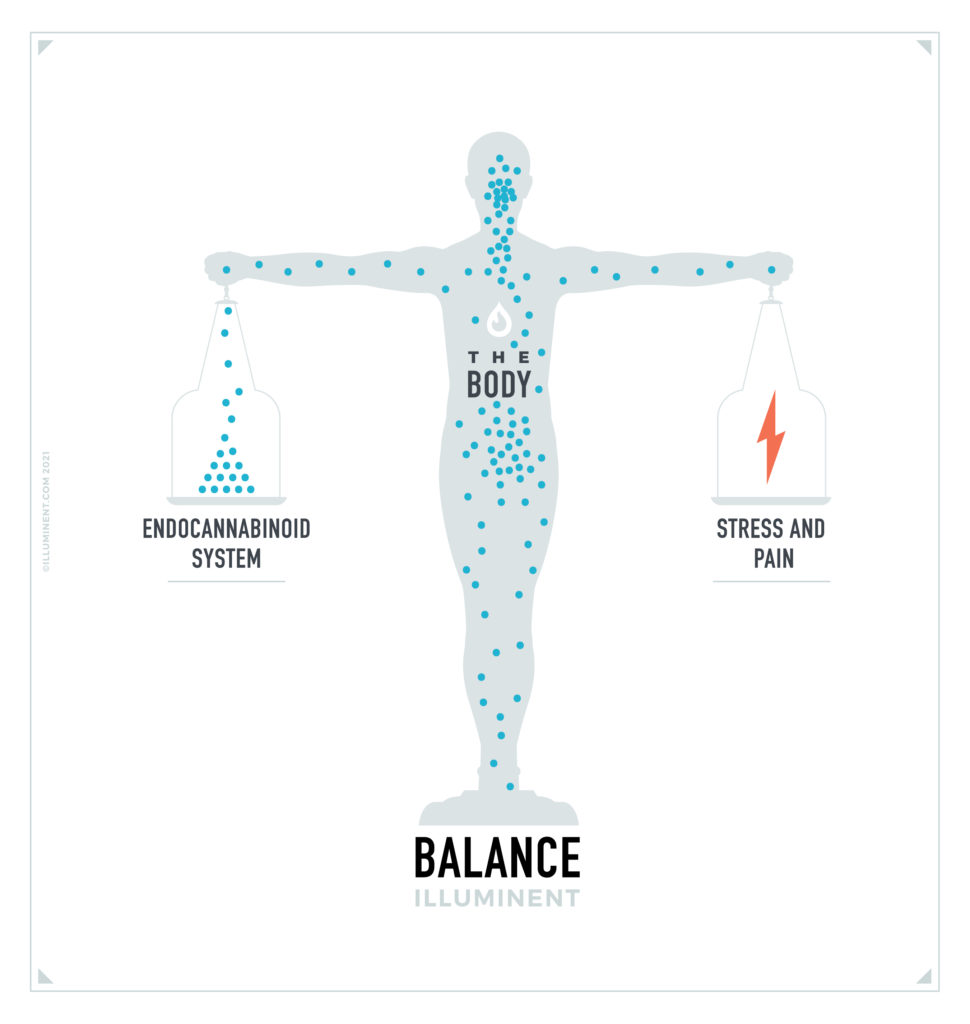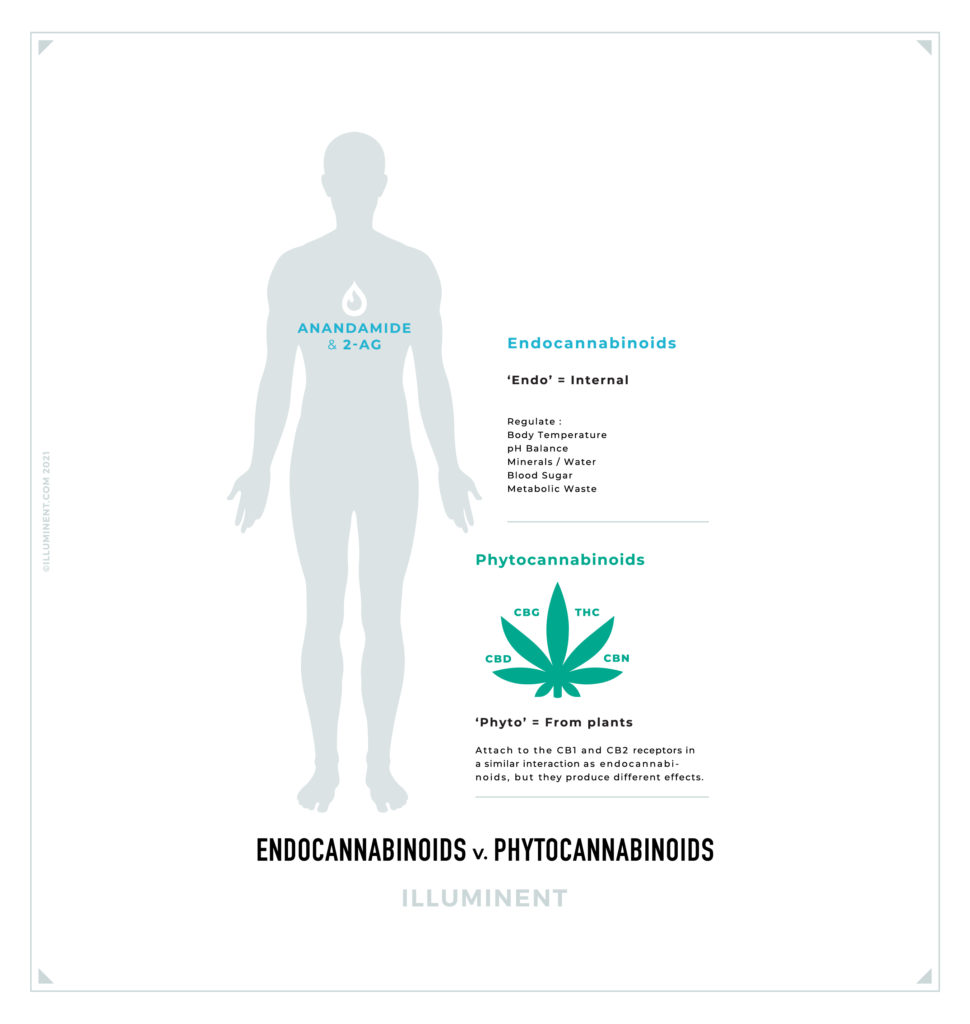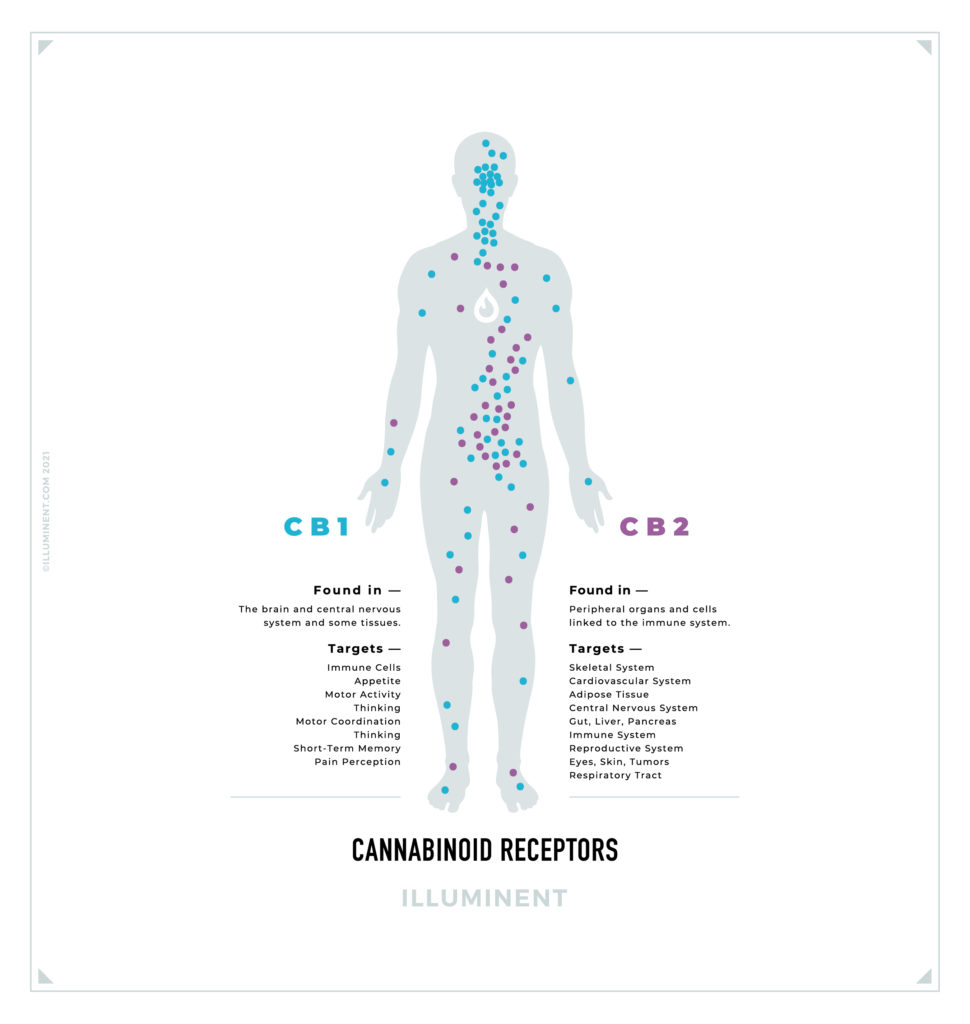
The human body is fascinating. As Science progresses, we have only recently begun to come to understand how the endocannabinoid system affects us. With looming legalization across much of the United States, understanding how this system works and responds to phytocannabinoids has just begun. Phytocannabinoids are cannabinoids such as CBD, Delta 9 THC, CBC, CBN, and Delta 8 THC (just to name the most known ones) which come directly from plants(phyto). As science comes out, it is essential that the public gain knowledge from a reputable source on this body system.
The Endocannabinoid system naturally produces the endocannabinoids; Anandamide and 2-AG, which help to regulate the body’s homeostasis. What this means, is that when the body is under stress or pain, the body seeks to balance itself by pushing these neurotransmitters to respond with endocannabinoids (Thus the body attempts to rebalance itself).

Phytocannabinoids are the cannabinoids that occur in plant material. They are not naturally occurring in the human body, however, they fit into the endocannabinoid system when introduced to the human body. Each of the phytocannabinoids have vastly different effects on the endocannabinoid system.

History Lesson:
The discovery that spearheaded a cultural revolution occurred in 1992 when a Czech scientist (Lumir Hanus) successfully isolated the first known endocannabinoid within the human brain. They named it anandamide, after the Sanskrit word for joy and bliss.
With the discovery of anandamide, it was proven the human brain produces cannabinoids on its own. This was contrary to previous science and opened all new ideas surrounding cannabis as a medicine. Much of the misunderstanding of cannabis today can be attributed to a lack of knowledge of the body’s endocannabinoid system.
By definition, the endocannabinoid system is a biological system that is composed of endocannabinoids. These include endogenous lipid-based retrograde neurotransmitters that can bind to cannabinoid receptors and cannabinoid receptor proteins throughout the brain, central nervous system, and peripheral nervous system. Contained within this system are endocannabinoids, enzymes, and receptors. The system supports the regulation of a variety of functions in humans, such as sleep, mood, memory, reproduction, appetite, and pain sensation.
There are two primary cannabinoid receptors that are currently identified, which are the CB1 and CB2 receptors:
Fun Fact: The endocannabinoid system plays a critical role in homeostasis, which is a biological regulation that keeps conditions balanced for optimal functioning. The endocannabinoid system is found in all species of animals on earth.
The endocannabinoid system is made up of three key components.
1. Cannabinoid Receptors
Overall, the cannabinoid receptors (CB1 and CB2) sit on the surface of cells and essentially “listen” to the cells’ conditions. They are responsible for transmitting information on any changing conditions to the inside of the cell and jumpstarting the appropriate cellular response. Keep in mind that CB1 and CB2 receptors are not the only ones, they are simply the first ones discovered and most well-studied.
2. Endocannabinoids
Endocannabinoids are small molecules that activate the cannabinoid receptors. In the same way, a phytocannabinoid (from the cannabis plant, such as Delta-8 THC), binds and activates cannabinoid receptors so do the natural endocannabinoids in our body. We and other animals have two major endocannabinoids: anandamide and 2-AG. Anandamide is a fatty acid neurotransmitter that is believed to impact working memory and the early stages of embryo development. While 2-AG can be found in high levels within the central nervous system and has been identified in human milk and maternal bovine. Its main function is to count the effects of inflammation caused on the central nervous system.
3. Metabolic Enzymes
Last is the metabolic enzymes, which break down endocannabinoids after they have been used. These enzymes quickly destroy used-up endocannabinoids and break down 2-AG. The two big ones are FAAH and MAGL. They are there to ensure the endocannabinoids get used when needed but do not stick around longer than necessary.

Delta-8 is an analog of delta-9. What this means, is that chemically it is very similar with one small difference in its structure. Delta-8 contains a bond on the 8th carbon chain, whereas delta-9 bonds with the 9th carbon chain. This creates differences between the two, primarily with the Delta 8 THC being less ready to bind to CB1 receptors (often why people call it THC light).
Delta 8 THC has been observed to soothe sore muscles, promote a sense of better mind-body awareness, sensory enhancement, increased giggling or laughing and promote mood lift. Because Delta 8 THC does not readily bind to the CB1 receptor, it is often a favorable option for some, as a cannabinoid that does not create paranoia or psychosis (As Delta 9 THC can in some users).
Delta-8 THC binds to the CB2 receptor as well, which is what is believed to give people profound therapeutic advantages, without the anxiety or paranoia typically encounter with delta-9 THC.
There are so many reasons people consume cannabis. From its mood-altering effects to legitimate relief, it is an amazing plant that can improve life quality for many. Keep in mind, cannabis would not provide therapeutic benefits if the human body did not already contain a biological system that could interact with chemical compounds like THC and CBD. Overall, the endocannabinoid system allows people to enjoy life to its fullest, sometimes with the aid of introducing Delta 8 THC.
With that being said, go ahead many are ready to try Delta-8. This cannabinoid is legal in 35 states, delivers mild psychoactive outcomes without any paranoia, and gives you that zero fogginess and engaged buzz you need. Not all companies are forthright in their honesty about how their Delta 8 THC was made. Please make sure that you invest in a company that values quality and rigorously tests its products. A good place to start is illuminent.com because when it comes to your endocannabinoid system, you deserve nothing but the best.
References:
1. Shane Johnson and Rod Kight. “THC Analogs – A Family Divided.” Kight on Cannabis The Definitive Word On Weed, Rod Kight, 12 Mar. 2020, https://cannabusiness.law/thc-analogs-a-family-divided/
2. Atakan, Zerrin. “Cannabis, a complex plant: different compounds and different effexts on individuals.” National Center for Biotechnology Information, U.S. National Library of Medicine, 2 Dec. 2012, https:// www.ncbi.nlm.nih.gov/pmc/
3. Rafa Laboratories. “Comparison of Delta-8-THC to Ondansetron in the Prevention of Acute Nausea From Moderately Emetogenic Chemotherapy – Full Text View.” Full Text View – ClinicalTrials.gov, Rafa Laboratories, 1 Feb. 2006, https://clinicaltrials.gov/ct2/show/NCT00285051
4. Abrahamov Aya, et al. “An Efficient New Cannabinoids Antiemetic In Pediatric Oncology.” An Efficient New Cannabinoid Antiemetic in Pediatric Oncology, Journal of the International Hemp Association, 1995, https://www.druglibrary.net/olsen/HEMP/IHA/iha02210.html
Illuminent products meet or exceed all federal guidelines for industrial hemp and are independently verified to contain 0.3% delta-9 THC prior to packaging.
These statements have not been evaluated by the FDA. Illuminent products are not intended to diagnose, treat, cure or prevent any disease.
©2022 ILLUMINENT. ALL RIGHTS RESERVED.